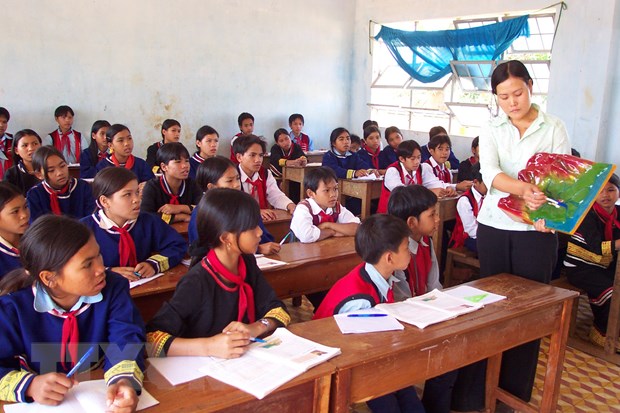 Society
Society


|
| Pupils from ethnic groups attend a class at the Boarding Ethnic Group School in Chư Sê District, Gia Lai Province. VNA/VNS Photo Văn Thông |
HÀ NỘI Physical and economic connectivity, market links and labor market mobility were among the top drivers distinguishing the best-performing ethnic groups, according to a study released by the World Bank (WB) yesterday.
Other factors included endowment of productive assets, access to education and healthcare, traditional institutions and local governance, gender roles, perception of ethnicity, and access to external support, according to the study, titled “Drivers of Socio-Economic Development Among Ethnic Minority Groups in Việt Nam”.
By shedding light on this intricate set of drivers behind the top-and bottom-performing ethnic groups, the study is expected to inform the ongoing revision of development policies and programmes for ethnic minorities, which are estimated to account for 84 per cent of the remaining poor population by 2020.
Minister Chairman of the Government Committee for Ethnic Minority Affairs Đỗ Văn Chiến applauded the timely support from the WB and the Australian Government, who sponsored the study.
“We find this research a valuable source of reference for our policy formulation process, especially at a time when we are now working with ministries and provinces to draw up a Master Proposal on a Comprehensive Investment Plan for Socio-Economic Development in the Ethnic Minorities, Mountainous and the Most Difficult Areas for the Post 2020 Period,” he said.
The poverty rate among Vietnamese ethnic minority groups was 23 per cent in 2016, three times higher than the national average.
According to the study, the pathway out of poverty for top-performing ethnic groups, which in this case were the Mường and Sán Dìu ethnic groups, depended partly on the good connection between where they live and basic infrastructure and economic clusters.
These groups were generally subject to better access and endowment of resources, enabling them to diversify their livelihood strategies. Particularly, these groups engaged in cash crops in addition to rice, actively looked for wage employment in factories, and found ways to interact with key stakeholders who determined resource allocation.
Another component of the study involves a policy mapping exercise to assess the extent to which existing policies promote these drivers. The mapping results indicate that the current system places emphasis mainly on physical connectivity and access to public services as well as credit, while leaving some areas “blank”.
The study suggests a number of policy recommendations, including refocusing future ethic minority development agenda and enhancing existing policies and mechanisms.
Future policies should focus on soft investment in production support and capacity development, access to the labour market and women’s economic empowerment while addressing misperceptions and social stigmas, it said. Meanwhile, current mechanisms should go beyond physical connectivity improvements towards strengthening market institutions and actors to support doing business in ethnic minority areas.
“From the study, we see tremendous opportunities to further advance the inclusion agenda by consciously adopting a differentiated approach towards development in ethnic minority areas,” said WB Country Director for Việt Nam Ousmane Dione.
“Việt Nam can count on the WB’s support in mainstreaming this agenda through investments in transport and infrastructure in rural and mountainous areas, agricultural diversification, as well as support for national targeted programmes,” he said. VNS




